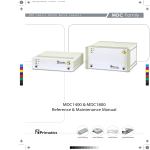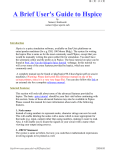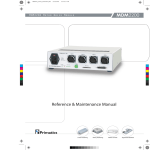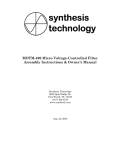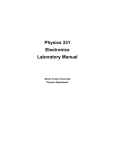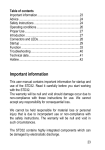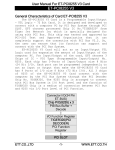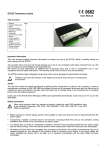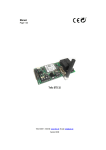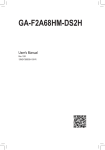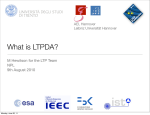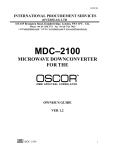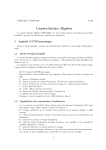Download MDC2100
Transcript
mdc2100_cover_06142006.pdf 6/15/2006 10:15:42 AM MDC2100 MDC2100 Motor Drive Chassis S E R I E S C M Y CM MY CY CMY K Reference & Maintenance Manual (MDC200, MDC400, MDC800) Linear Positioning Rotary Positioning Motion Controls Engineered Solutions Reference & Maintenance Manual 32114 Mallard Ave. PO Box 409 Tangent, OR 97389-0409 U.S.A. Phone: Fax: Toll Free: Web: E-mail: [541] 791-9678 [541] 791-9410 [888] 754-3111 www.primatics.com [email protected] MDC2100 Manual Revision Information Publication Date December 2003 April 2005 November 2006 December 2006 Notes First Release Updated look & formatting Manual Maintenance & Pinout Update Modified Table 7.3 Notice: Any descriptions, drawings, and specifications contained herein are subject to change. Primatics is not responsible for errors or omissions herein or for incidental damages in connection with the furnishing or use of this information. This document shall not be reproduced, photocopied, or duplicated, in whole or in part, without prior written approval of Primatics Corporation. For additional specifications, dimensioned drawings and additional information, refer to the MDC2100 Datasheet available from our website at www.primatics.com. ©Copyright 2007 by Primatics, Inc; All Rights Reserved. Primatics, the Primatics logo, PrimaFlex, PrimaSeal & SimpleMatch are trademarks of Primatics, Inc. 1 Reference & Maintenance Manual Manual Revision Information ........................................................... 1 1) Overview......................................................................................... 3 2) Introduction – About the MDC2100 Family................................. 4 3) Model Configuration ..................................................................... 5 4) Personal Safety ............................................................................. 6 5) Installation...................................................................................... 7 5.1) Locating the MDC2100 .............................................................................................................................7 5.2) Front Panel Indicators and Controls..........................................................................................................8 5.3) Rear Panel Information ..............................................................................................................................9 5.3.1) Communication Ports: RS-232, Ethernet ..........................................................................................9 5.3.2) The I/O Port Pinout ...........................................................................................................................10 5.3.3) Auxiliary Encoder Option ................................................................................................................11 5.4) The Safety Port .........................................................................................................................................12 5.4.1) Stop Loop and Stop Switch ..............................................................................................................12 5.5) Axis Information ......................................................................................................................................13 6) Operations.................................................................................... 15 6.1) Fault Detection and Motor Power Control .............................................................................................15 6.2) Motor Output Signals...............................................................................................................................16 6.2.1) Brushless Servo Motor......................................................................................................................16 6.3) Encoder Input ...........................................................................................................................................17 6.4) Limit, Home & Temp Sensors.................................................................................................................18 6.5) Brake Release Output...............................................................................................................................18 7) The Galil DMC Interface .............................................................. 19 7.1) The I / O Port ............................................................................................................................................19 7.2) Overview...................................................................................................................................................19 7.2.1) MDC Digital Inputs and Outputs .....................................................................................................20 7.3) The MDCOptima Application Programming Interface .........................................................................21 7.3.1) The API..............................................................................................................................................21 7.3.2) Motor Power Control ........................................................................................................................21 7.3.3) Brakes ................................................................................................................................................22 7.4) Software Installation ................................................................................................................................23 7.4.1) Set the Controller Parameters...........................................................................................................23 7.4.2) Setting Motion Control Parameters for each axis ...........................................................................23 7.4.3) Loading the API ................................................................................................................................23 7.4.4) Example 1 – Brushless Servo - Trapezoidal Drive .........................................................................23 7.5) Appendices................................................................................................................................................26 7.5.1) Appendix A – MDCOptima API......................................................................................................26 8) Troubleshooting & Service ........................................................ 28 8.1) Troubleshooting Help...............................................................................................................................28 8.2) Service.......................................................................................................................................................28 2 Reference & Maintenance Manual 1) Overview This user guide is designed to help you install and maintain your MDC Series motion control. Follow these steps to ensure correct installation and maximum life: Step 1 Review this entire user manual. Become familiar with all installation procedures prior to integrating your system. Step 2 Review the safety summary to develop an understanding of standard safety practices when installing and operating automated equipment. Step 3 Review installation procedures. For best results, follow these procedures carefully. 3 Reference & Maintenance Manual 2) Introduction – About the MDC2100 Family This manual is intended for use by application engineers and technicians involved with Primatics positioning equipment. The MDC2100 is a complete motion control system in a small package. It combines a programmable motion controller (Galil DMC-21x3), servo drives, power supplies, and all necessary wiring into a single package. The MDC2100 is optimized for controlling Primatics positioning stages and mechanisms, but can also be used with third party positioning stages or axes. A variety of cable assemblies are available to connect positioning stages or axes to the MDC. The diagram to the left shows the role of a MDC in a motion control system. The integrated Galil DMC-21x3 programmable motion control card makes the MDC a powerful element in a motion control system. The DMC-21x3 can be programmed via its integrated RS-232 or 10BaseT Ethernet connection and operates as a stand alone system using the Galil’s internal program memory storage capability. The Galil DMC-21x3 is a multi-tasking, multi-axis, high performance motion controller. Refer to the Galil DMC-21x3 programming and users manuals for more information. 4 Reference & Maintenance Manual 3) Model Configuration 5 Reference & Maintenance Manual 4) Personal Safety Please review before installing your motion system Observe common industrial safety practices when installing and operating automated equipment. o Have power connections made by qualified personnel. o Keep fingers and other items out of any opening in the stage while it is in operation since injury or damage may result. o Provide a safe access route and adequate room for servicing. o Perform the recommended periodic maintenance described in this document. o Verify that the work envelope is free of obstructions before the positioning stage is powered. o Insure that for servo motors the encoder must be working properly and the polarity of the encoder needs to match the polarity of the motor before enabling the servo drive. Improper feedback connections can cause a motor run-away condition that has the potential to damage the stage and injure an operator. o Only trained operators of the positioning stage should be allowed near the work environment. o Identify emergency stop circuits and actuators in the workcell. In an emergency press the yellow stop button on the drive chassis front panel. This cuts power to all axes amplifiers. o Note the places in the workcell where pinch points occur, and provide adequate safety clearance or safety curtain. o Never operate the motor in a location that could be splashed by water, exposed to corrosive or flammable gases or is near combustible substances since this may cause an electric shock, fire or malfunction. o Never touch the motor, driver, or peripheral devices when the power is on or immediately after the power is turned off. The high temperature of these parts may cause burns. 6 Reference & Maintenance Manual 5) Installation 5.1) Locating the MDC2100 A typical motion system consists of the MDC, axis cables and positioning stages. The Motion Controller Card is housed inside the MDC. The MDC also includes Motor Drive Connectors for each axis of travel; these Motor Drive Connectors connect to stages with axis cables. Figure 5-1 shows a typical system. Figure 5-1: MDC2100 Motion System The MDC must be placed in a convenient location for connection to both the PC and your stages. Access to the front panel controls and the rear panel connectors must be considered before installation. There are no user serviceable parts in the chassis, but axis cards and motion control interface cards are “plug-in” assemblies that can be removed and installed from the rear of the chassis. 7 Reference & Maintenance Manual Figure 5-2: Dimensions of MDC2100 5.2) Front Panel Indicators and Controls Figure 5-3: Front Panel SYSTEM POWER is illuminated whenever power is applied to the chassis, and the power switch on the rear is turned on. MOTOR POWER is illuminated when the internal motor power supply is turned on. FAULT is illuminated whenever any condition exists that prevents the motor power supply to be turned on. STOP is connected into the STOP loop described in 5.4. 8 Reference & Maintenance Manual 5.3) Rear Panel Information All connections to the MDC are made at the rear of the chassis. Connections include AC power, communications to the DMC-21x3, I/O from the DMC-21x3, and signals for the attached positioning stages or axes. Figure 5-4: Galil Communications Connections 5.3.1) Communication Ports: RS-232, Ethernet Communication to the integrated Galil DMC-21x3 can use either the RS-232 port or Ethernet port as indicated. The RS-232 port operates at 19.2K. The Ethernet port is a 10BaseT port. Refer to the Galil DMC-21x3 User Manual, Chapter 4 for detailed information about both of these interfaces. The factory default IP address is 192.168.0.60. 9 Reference & Maintenance Manual 5.3.2) The I/O Port Pinout The third connector is the I/O connector located on the rear of the MDC chassis. This port provides access to certain Input, Output, Status, and Control signals from the Galil motion control card. The pin definition for this port is shown Table 5-1 below. Please note that many of the signals in the I/O Port are TTL logic levels. Power supply signals are included in the port for users that want to provide external signal conditioning. If you want internal signal conditioning for your application, contact the factory. Table 5-1: I/O Port Pinout: Connector: DB25S Mate: DB25P Pin 1 14 2 15 3 16 4 17 5 18 6 19 7 20 8 21 9 22 10 23 11 24 12 25 13 Name USER IN 1 USER IN 2 USER IN 3 USER IN 4 USER OUT 1 USER OUT 2 USER OUT 3 AIN 1 AIN 2 AIN 3 AIN 4 AIN 5 AIN 6 AIN 7 AIN 8 ABORT ENC CMP ERROR USER OUT 4 NC +12VDC -12VDC GND GND 5VDC Description TTL input TTL input TTL input TTL input TTL output TTL output TTL output Analog Input 1 Analog Input 2 Analog Input 3 Analog Input 4 Analog Input 5 Analog Input 6 Analog Input 7 Analog Input 8 TTL input. Abort input of Galil card. Active low. TTL output. Encoder Compare output of Galil card. TTL output. Error output TTL output No connection Power supply, 12VDC, 150mA max. Power supply, -12VDC, 100mA max. DC common for power supplies and signals see pin 12 Power supply, 5VDC, 200mA max. 10 Reference & Maintenance Manual 5.3.3) Auxiliary Encoder Option An available option for the MDC2100 is the Auxiliary Encoder Connector. This allows connection to secondary encoders for dual-loop operation. Table 5-2: Auxiliary Encoder Pinout: Connector: DB25S Mate: DB25P Pin 1 14 2 15 3 16 4 17 5 18 6 19 7 20 8 21 9 22 10 23 11 24 12 25 13 Name 5VDC DCCOM AUXA A+ AUXA AAUXA B+ AUXA B5VDC DCCOM AUXB A+ AUXB AAUXB B+ AUXB B5VDC DCCOM AUXC A+ AUXC AAUXC B+ AUXC B5VDC DCCOM AUXD A+ AUXD AAUXD B+ AUXD BCHASSIS Description Encoder Power Power Common Auxiliary Encoder Axis A, A+ Auxiliary Encoder Axis A, AAuxiliary Encoder Axis A, B+ Auxiliary Encoder Axis A, BEncoder Power Power Common Auxiliary Encoder Axis B, A+ Auxiliary Encoder Axis B, AAuxiliary Encoder Axis B, B+ Auxiliary Encoder Axis B, BEncoder Power Power Common Auxiliary Encoder Axis C, A+ Auxiliary Encoder Axis C, AAuxiliary Encoder Axis C, B+ Auxiliary Encoder Axis C, BEncoder Power Power Common Auxiliary Encoder Axis D, A+ Auxiliary Encoder Axis D, AAuxiliary Encoder Axis D, B+ Auxiliary Encoder Axis D, BChassis Connection 11 Reference & Maintenance Manual 5.4) The Safety Port At the rear of the MDC chassis is a pluggable terminal strip labeled Safety Port. The Safety Port provides connection access to two features: the Stop Loop and the Stop Switch. 5.4.1) Stop Loop and Stop Switch To enhance the safety of an application, the motor power supply in the MDC uses an external Stop Loop to control the state of its motor power circuit. For normal operation of the motor power supply, the Stop Loop found on pins 3 and 4 of the Safety Port must form a closed circuit. An open Stop Loop will generate internal STOP and hardware faults, killing power to the motors. The Stop Switch on the front panel of the MDC chassis is a normally closed switch connected between pins 1 and 2 of the Safety Port. If no external devices are to be connected to the Stop Loop, the Stop Switch must be connected as shown in Figure 5-5. Figure 5-5: Stop Switch and Stop Loop connections (pins 1, 2, 3 and 4 of Safety Port) To connect the MDC safety system to external devices, such as an external STOP switch, light curtain, etc, insert the normally closed circuit from the safety devices into one of the two loops show in Figure 5-5. Assure that the safety circuit is a dry contact. 12 Reference & Maintenance Manual 5.5) Axis Information Primatics linear and rotary stages are connected to the MDC chassis using the Servo Axis Cable accessory. The standard cable is 12 ft. long, but cables up to 50 ft. in length can be used. Connect the cable from the appropriate axis connector at the rear of the MDC chassis to the stage. The Axis connectors are associated to Galil axes A through D. Only those connectors for the ordered configuration are present. For example: a 2axis MDC2100 will have connectors for axes A & B only. Figure 5-6: Axis Connectors and Galil Association 13 Reference & Maintenance Manual Table 5-3 shows the pin-out of the Axis connectors. Table 5-3: Servo Axis Connector Pin-out Connector: FCI UTG020-S Mate: FCI UTG620-28PN Pin A B C D E F G H J K L M N P R S T U V W X Y Z a b c d Name MOT A MOT B MOT C MOT SHLD ENC 5V ENC A+ ENC AENC B+ ENC BENC SHLD LIMIT 12V LIMIT COM HOME BRAKE+ BRAKESHIELD HALL V+ HALL VENC VENC I+ ENC IFLS RLS not used HALL A HALL B TEMP e HALL C Function Motor phase A Motor phase B Motor phase C Shield for motor signals, connect to motor case. Encoder power supply, 5VDC Encoder channel A+ Encoder channel AEncoder channel B+ Encoder channel BShield for encoder signals, connect to encoder case. Power supply for limit switches, 12VDC power supply return for limit switches. Home signal input Failsafe brake power output, 24VDC to release brake return for brake power output Shield for cable Limit switch power output, 5VDC return for limit switch power output Return for Encoder power Encoder channel I+ Encoder channel IForward limit switch input. Connect to LIMIT COM for normal operation. Reverse limit switch input. Connect to LIMIT COM for normal operation. Hall sensor A input Hall sensor B input Motor temperature switch input. Connect to LIMIT COM for normal operation. Hall sensor C input 14 Reference & Maintenance Manual 6) Operations 6.1) Fault Detection and Motor Power Control For the MDC, a fault is any condition that will prevent power from being applied to the motor drives. There are two DC power systems in the MDC chassis: the Logic supply and the Motor supply. The Logic supply provides DC power to all internal circuits as well as externally connected encoders, limit and home sensors, and optional brakes. The Logic supply is on anytime AC power is supplied and the power switch is on. This condition is indicated with the illumination of the SYSTEM POWER indicator on the front panel. The Motor supply provides the DC power to all of the motor drives. This power supply is on only if there are no fault conditions, and the motion controller has turned on the supply through its I/O signals. A fault condition will override the signals from the motion controller and turn off the motor supply. If a fault condition occurs, the source of the fault must be removed, and the condition must be re-set using I/O signals from the motion controller. A Fault condition is indicated by the illuminated FAULT indicator on the front panel. This condition is caused when any of the following occur: • • • System power turn-on Power Supply Fault STOP LOOP on SAFETY PORT is open The state of the Fault as well as the cause of the fault may be determined through input signals to the motion controller. 15 Reference & Maintenance Manual 6.2) Motor Output Signals 6.2.1) Brushless Servo Motor The brushless servo motor drives control current through the three phases of a brushless motor. The motor is commutated with hall sensors. Figure 6-1 shows the timing diagram for the motor phases and commutation sensors. Figure 6-1: Motor commutation chart 16 Reference & Maintenance Manual 6.3) Encoder Input The encoder input is necessary to operate the motor. The encoder inputs are compatible with RS-422 differential signals commonly used on industrial encoders. Figure 6-2 shows the timing diagram for the encoder input. Figure 6-2: Encoder signal timing diagram for positive motion 17 Reference & Maintenance Manual 6.4) Limit, Home & Temp Sensors The MDC2100 supports monitoring a forward limit, reverse limit, and home sensor for each axis. Figure 6-3 shows an equivalent schematic for the limit, home, and temperature inputs. Note that the MDC2100 has a 12V supply available to power external sensor circuits. Figure 6-3: Sensor Input Circuit Diagram 6.5) Brake Release Output Each axis includes a circuit to energize (supply power to) a fail-safe brake. A fail-safe brake will hold an axis from moving when no power is applied to the brake. The brake release output will supply 24VDC to a brake when the output is on. The brake release output is on only when all of these conditions are satisfied: • • • • Motor power supply is on The drive amplifier is enabled by the motion controller The drive amplifier has no faults The brake release enable output bit from the motion controller is on 18 Reference & Maintenance Manual 7) The Galil DMC Interface 7.1) The I / O Port This port provides access to certain Input, Output, Status, and Control signals from the Galil motion control card. The pin definition for this port is shown in Table 7-1. Please note that many of the signals in the I/O Port are TTL logic levels. Power supply signals are included in the port for users that want to provide external signal conditioning. If you want internal signal conditioning for your application, contact the factory. Table 7-1) I/O Port Pinout: Connector: DB25S Mate: DB25P Pin 1 14 2 15 3 16 4 17 5 18 6 19 7 20 8 21 9 22 10 23 11 24 12 25 13 Name USER IN 1 USER IN 2 USER IN 3 USER IN 4 USER OUT 1 USER OUT 2 USER OUT 3 ANALOG IN 1 ANALOG IN 2 ANALOG IN 3 ANALOG IN 4 ANALOG IN 5 ANALOG IN 6 ANALOG IN 7 ANALOG IN 8 ABORT ENC CMP ERROR NC NC +12VDC -12VDC GND GND 5VDC Description TTL input TTL input TTL input TTL input TTL output TTL output TTL output AIN 1 of Galil card AIN 2 of Galil card AIN 3 of Galil card AIN 4 of Galil card AIN 5 of Galil card AIN 6 of Galil card AIN 7 of Galil card AIN 8 of Galil card TTL input. Abort input of Galil card. Active low. TTL output. Encoder Compare output of Galil card. TTL output. Error output No connection No connection Power supply, 12VDC, 100mA max. Power supply, -12VDC, 100mA max. DC common for power supplies and signals see pin 12 Power supply, 5VDC, 200mA max. 7.2) Overview The Galil DMC 21x3 series controllers provide motion control for up to four axes of motion. Cards that support 1 to 4 axes of motion supply eight inputs and eight outputs. Output bits 4-8 and input bits 5-8 are dedicated to internal functions leaving 3 uncommitted outputs and 4 uncommitted inputs available to the user through I/O connector 1. 19 Reference & Maintenance Manual 7.2.1) MDC Digital Inputs and Outputs Five outputs are dedicated to programmatic operation of the MDC2100. Motor Power Enable and Reset Faults are used to control the motor power circuit. The Brake Release Enable is used to enable the release of failsafe brakes. Table 7-2) Controller Digital Outputs 1 2 3 4 5 6 7 8 MDC 1 Outputs User Output 1 User Output 2 User Output 3 Unused MDC1 Motor Power Enable MDC1 Reset Faults Unused MDC1 Brake Release Enable Table 7-3) Inputs 1 2 3 4 5 6 7 8 MDC 1 Inputs User Input 1 User Input 2 User Input 3 User Input 4 MDC 1 Motor Power is Off MDC 1 Hardware Fault MDC 1 ESTOP Fault MDC 1 Logic Power Fault 20 Reference & Maintenance Manual 7.3) The MDCOptima Application Programming Interface 7.3.1) The API The application programming interface (API) for the MDC Optima is a set of programs, which reside on the controller card. The programs provide motor power control, and brake control. For each program, a variable with the same name is provided to indicate routine completion. The program variable is set to 1 when the routine completes execution. A program running on the PC can set the variable to zero, execute an API routine and then poll the value of the variable to determine when the routine has finished. Appendix A contains a program listing. 7.3.2) Motor Power Control Table 7-4) Motor Power Control Programs Program CF MPOFF MPON Description Clear faults Turn motor power off Turn motor power on The CF program attempts to reset the hardware faults. First the ESTOP fault and logic power fault latches are reset and then the hardware fault latch is reset. The fault latch cannot be reset if faults are still active. The MPOFF program is used to turn off motor power to all axes. It turns off the enable motor power output, turning motor power off to all motor drivers (amplifiers). In addition, the Galil motor off (MO) command is issued to all axes. This turns off the amplifier enable signal and opens the servo loop for each axis. The MPON program is used to turn motor power on for all axes. First it issues a Galil motor off command for all axes. This is done so that the actuators will not jump when motor power is applied. Next, the enable motor power is turned off and then on. If there are no faults, this action will turn on the motor power relay, providing power to the motor drivers. The user must then issue the Galil servo here (SH) command to activate the amplifier enable signal and close the servo loop at the current position for all axes to be powered up. Note: The API programs TA, TD, ELA, ELB & DIM1 are not used with the MDC2100 21 Reference & Maintenance Manual 7.3.3) Brakes Table 7-5) Brake Programs Program DBR1 EBR1 TBR1 Description Disable brake release, drive 1 Enable brake release, drive 1 Tell brake release status, drive 1 Each axis has a failsafe brake circuit. The brake release signal for an axis is activated if motor power is on, the amplifier is enabled and not faulted, and the brake release is enabled. The DBR1 program turns off the enable brake release output for the MDC2100, disabling the brake release for axes A and B. The EBR1program turns on the brake release output. The TBR1 program is used to obtain the state of the brake release output. It sets the variable TBR1VAL to 1 if the enable brake release output is on and 0 otherwise. 22 Reference & Maintenance Manual 7.4) Software Installation This section discusses the steps required to configure motion cards for the Primatics motor drive chassis and stages. The MDCOptima API is provided on the disk labeled Primatics MDCOptima API (Part Number 0-6950-0001). One file on the disc contains motion control parameters, another file contains controller API and utility programs and another file is called README.TXT and has instructions on how to use the other two files, configure the motion control card, turn on power, close the servo loop, home the axes, set the cycle speeds, and start and stop the program. The motion control parameters used at the factory are supplied with each stage. Some parameters will need to be modified depending on the particular application (e.g. tuning parameters). 7.4.1) Set the Controller Parameters Set the BA command to specify which axes require sinusoidal commutation. Use the CN command to specify the limit switch polarity. 7.4.2) Setting Motion Control Parameters for each axis Appendix A contains a sample motion control parameters sheet provided with PLG and PLR series stages. Using the Galil DMC Terminal Program or the Set-up and Configure Form of the Servo Design Kit enter the motion control parameters. Don’t forget to save the setting in nonvolatile memory. 7.4.3) Loading the API To use the API, it must be included with the application code and downloaded to the motion card. The examples below are in the form of a DMC Terminal program session. In these terminal sessions, the characters typed by the user are in regular type and the controller response is in bold italics. 7.4.4) Example 1 – Brushless Servo - Trapezoidal Drive It is an example of a controller with one brushless servo – trapezoidal drive. The drive is connected to the A (X) axis. The stage has an encoder ratio of 800 counts/mm and equipped with a failsafe brake. The following instructions are issued via the DMC Terminal program: 7.4.4.1) Controller configuration Instruction BA CN 1 Interpretation All axes are cleared for sinusoidal commutation (The servo driver is of Trapezoidal type). Limit switches active high 23 Reference & Maintenance Manual 7.4.4.2) Axis A configuration Instruction MTA=1 CEA=0 DVA=0 KDA=20 KPA=4 KIA=1 ILA=2 TLA=9.998 OFA=0 ERA=800 OEA=1 FAA=0 FVA=0 ACA=2400000 DCA=2400000 MO;BN Interpretation Motor type is servo Main encoder and auxiliary encoder are normal quadrature. Dual loop filter mode is disabled Derivative constant Proportional constant Integrator Integrator limit Torque limit Offset Error limit Off on error enabled Acceleration feedforward Velocity feedforward Set acceleration (3000mm/sec) Set deceleration (3000mm/sec) Save parameters 7.4.4.3) Preparing the axis to move Instruction XQ#CF XQ#TD TDVAL= 17.000 XQ#MPON XQ#TD TDVAL= 16 SHA XQ#TA TAVAL= 30 XQ#EBR1 Interpretation Clear latched faults Obtain MDC0200 status Bit 0 is 1 indicating motor power is off. Bits 1, 2, and 3 are 0 indicating that there is no hardware, system power or ESTOP faults. Enable MDC0200 power. Obtain MDC0200 status Bit 0 is 0 indicating motor power is on. Close servo loop Obtain amplifier status Bit 0 is 0 indicating the A axis amplifier is OK. Activate the MDC1 failsafe brake release enable signal. Now, the axis A failsafe brake will release since motor power is on, the SH command has been issued, and the amplifier is OK. 24 Reference & Maintenance Manual 7.4.4.4) Home using encoder latching Instruction CN,-1 SPA=40000 FEA;BGA AMA;TPA -39921 XQ#ELA SPA=20000 PRA=-8000 BGA AMA;TPA -47921 MG _ALA 0.0 RLA -41239 PAA=_RLA BGA;AMA DPA=0 Interpretation Home switch active low Set speed to 50mm/sec Move to the home sensor transition neighborhood When the motion is complete, report the current position Route encoder index signal to input 1 and arm latch Set the move speed (do not exceed 20000 counts/sec) Setup a relative move of –10mm Initiate move When the motion is complete, report the current position The latch is not armed indicating the encoder index transition was detected. Report the latched position. Setup a move to the latched position Start move and wait for move completion Define the latched position to be the home position 25 Reference & Maintenance Manual 7.5) Appendices 7.5.1) Appendix A – MDCOptima API NO ========================== NO Primatics, Inc. NO MDCOptima API NO Version 1.0 NO ========================== NO -- Terminology NO MDC0200 Motor Drive Chassis NO x Axis A,B,C,D,E,F,G,H NO d MDC0200 1,2 NO -- Programs NO #CF Clear faults, both MDCs NO #DBRd Turn off brake release enable, MDC0200 d NO #DIMd Disable input multiplexer MDC0200 d NO #EBRd Enable brake release MDC0200 d NO #ELx Enable latching of index pulse x axis NO #MPOFF Turn motor power off, both MDCs NO #MPON Turn motor power on, both MDCs NO #TA Axes amplifier status NO TAVAL - Bitwise amp status NO Bits 0 - 7 = Axes A - H, 1=Faulted NO #TBRd Tell if brake release enable is on, MDC0200 d NO TBRdVAL - 1=Enable brake release output is on NO #TD MDC0200 1 & 2 status NO TDVAL - Bitwise MDC0200 status NO Bits 0-3=MDC1, 4-7=MDC2 NO Bit Description 1= NO 0,4 Motor Power On? Off NO 1,5 Hardware Ok? Faulted NO 2,6 Logic Power Ok? Faulted NO 3,7 ESTOP Ok? Faulted NO -- Labels NO #TBR1A,#TBR2A NO -- Variables used NO Completion codes NO CF,DBR1,DBR2,DIM1,DIM2,EBR1,EBR2 NO ELA,ELB,ELC,ELD,ELE,ELF,ELG,ELH NO MPOFF,MPON,TA,TBR1,TBR2,TD NO Status variables NO TAVAL, TBR1VAL, TBR2VAL, TDVAL #CF CB6;WT100;SB6;WT100;CB14;WT100;SB14;WT100; CB6;WT100;SB6;WT100;CB14;WT100;SB14;WT100;CF=1;EN #DBR1 CB8;DBR1=1;EN #DBR2 CB16;DBR2=1;EN #DIM1 CB4;DIM1=1;EN 26 Reference & Maintenance Manual #DIM2 CB12;DIM2=1;EN #EBR1 SB8;EBR1=1;EN #EBR2 SB16;EBR2=1;EN #ELA SB4;CN,,-1;ALA;ELA=1;EN #ELB SB4;CN,,-1;ALB;ELB=1;EN #ELC SB4;CN,,-1;ALC;ELC=1;EN #ELD SB4;CN,,-1;ALD;ELD=1;EN #ELE SB12;CN,,-1;ALE;ELE=1;EN #ELF SB12;CN,,-1;ALF;ELF=1;EN #ELG SB12;CN,,-1;ALG;ELG=1;EN #ELH SB12;CN,,-1;ALH;ELH=1;EN #MPOFF MO;CB5;CB13;MPOFF=1;EN #MPON MO;CB5;CB13;WT 50;SB5;SB13;MPON=1;EN #TA SB7;SB15;TAVAL=@INT[_TI0/16]+(_TI1&$F0);TA=1;EN #TBR1 TBR1VAL=1;JP #TBR1A, _OP0&128;TBR1VAL=0 #TBR1A;TBR1=1;EN #TBR2 TBR2VAL=1;JP #TBR2A, _OP0&32768;TBR2VAL=0 #TBR2A;TBR2=1;EN #TD CB7;CB15;TDVAL=@INT[_TI0/16]+(_TI1&$F0);TD=1;EN 27 Reference & Maintenance Manual 8) Troubleshooting & Service 8.1) Troubleshooting Help For further assistance contact the factory: M-F 8AM to 5PM Pacific Time Phone: Fax: Toll Free: Web: E-mail: [541] 791-9678 [541] 791-9410 [888] 754-3111 www.primatics.com [email protected] 8.2) Service Should your device require factory service, contact the factory for a Return Materials Authorization (RMA). When inquiring about an RMA please have the following information available: o Your contact information (name, phone, email, address) o Unit Serial Number (located on label near the power switch) o Symptom of problem o History of troubleshooting steps already taken 28





























